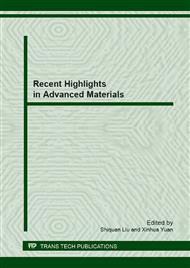[1]
M. Niinomi, Fatigue performance and cyto-toxicity of low rigidity titanium alloy, Ti-29Nb-13Ta-4. 6Zr, Biomaterials. 24 (2003) 2673-2683.
DOI: 10.1016/s0142-9612(03)00069-3
Google Scholar
[2]
Rho JY, Tsui TY, Pharr GM, Elastic properties of human cortical and trabecular lamellar bone measured by nanoindentation, Biomaterials. 18 (1997) 1325-1330.
DOI: 10.1016/s0142-9612(97)00073-2
Google Scholar
[3]
N. Sumitomo, K. Noritake, T. Hattori, K. Morikawa, S. Niwa, K. Sato, M. Niinomi, Experiment study on fracture fixation with low rigidity titanium alloy, J Mater Sci. 19 (2008) 1581-1586.
DOI: 10.1007/s10856-008-3372-y
Google Scholar
[4]
D. Kuroda, M. Niinomi, M. Morinaga, Y. Kato, T. Yashiro, Design and mechanical properties of new b type titanium alloys for implant materials, Mater Sci Eng A. 243 (1998) 244-249.
DOI: 10.1016/s0921-5093(97)00808-3
Google Scholar
[5]
H. Matsumoto, S. Watanabe, S. Hanada, Beta TiNbSn alloys with low Young's modulus and high strength, Mater Trans. 46 (2005) 1070-1078.
DOI: 10.2320/matertrans.46.1070
Google Scholar
[6]
Y.L. Hao, S.J. Li, S.Y. Sun, R. Yang, Effect of Zr and Sn on Young's modulus and superelasticity of Ti-Nb-based alloys, Mater Sci Eng A. 441 (2006) 112-118.
DOI: 10.1016/j.msea.2006.09.051
Google Scholar
[7]
Y. Okazaki, S. Rao, Y. Ito, T. Tateishi, Corrosion resistance, mechanical properties, corrosion fatigue and cytocompatibility of new Ti alloys without Al and V, Biomaterials. 19 (1998) 1197-1215.
DOI: 10.1016/s0142-9612(97)00235-4
Google Scholar
[8]
J.P. Steib, R. Dumas, D. Mitton, W. Skalli, Surgical correction of scoliosis by in situ contouring: a detorsion analysis, Spine. 29 (2004) 193-199.
DOI: 10.1097/01.brs.0000107233.99835.a4
Google Scholar
[9]
M. Nakai, M. Niinomi, X.F. Zhao, X.L. Zhao, Self-adjustment of Young's modulus in biomedical titanium alloys during orthopaedic operation, Mater Lett. 65 (2011) 688-690.
DOI: 10.1016/j.matlet.2010.11.006
Google Scholar
[10]
M. Abdel-Hady, K. Hinoshita, M. Morinaga, General approach to phase stability and elastic properties of b-type Ti-alloys using electronic parameters, Scripta Mater. 55 (2006) 477-480.
DOI: 10.1016/j.scriptamat.2006.04.022
Google Scholar
[11]
X.F. Zhao, M. Niinomi, M. Nakai, J. Hieda, T. Ishimoto, T. Nakano, Optimization of Cr content of metastable b-type Ti-Cr alloys with changeable Young's modulus for spinal fixation applications, Acta Biomater. 8 (2012) 2392-2400.
DOI: 10.1016/j.actbio.2012.02.010
Google Scholar
[12]
X.F. Zhao, M. Niinomi, M. Nakai, J. Hieda, Beta type Ti-Mo alloys with changeable Young's modulus for spinal fixation applications, Acta Biomater. 8 (2012) 1990-(1997).
DOI: 10.1016/j.actbio.2012.02.004
Google Scholar
[13]
X.L. Zhao, M. Niinomi, M. Nakai, G. Miyamoto, T. Furuhara, Microstructures and mechanical properties of metastable Ti-30Zr-(Cr, Mo) alloys with changeable Young's modulus for spinal fixation applications, Acta Biomater. 7 (2011) 3230-3236.
DOI: 10.1016/j.actbio.2011.04.019
Google Scholar
[14]
J.I. Qazi, B. Marquardt, L.F. Allard, H.J. Rack, Phase transformations in Ti-35Nb-7Zr-5Ta-(0. 06-0. 68)O alloys, Mater Sci Eng C. 25 (2005) 389-397.
DOI: 10.1016/j.msec.2005.01.022
Google Scholar
[15]
J.C. Williams, D. de Fontaine, and N.E. Paton, The w-phase as an example of an unusual shear transformation, Metall Trans. 4 (1973) 2701-2708.
DOI: 10.1007/bf02644570
Google Scholar
[16]
D. de Fontaine, N.E. Paton, and J.C. Williams, The omega phase transformation in titanium alloys as an example of displacement controlled reactions, Acta Metall. 19 (1971) 1153-1162.
DOI: 10.1016/0001-6160(71)90047-2
Google Scholar
[17]
X.L. Zhao, M. Niinomi, M. Nakai, T. Ishimoto, T. Nakano, Development of high Zr-containing Ti-based alloys with low Young's modulus for use in removable implants, Mater Sci Eng C. 31 (2011) 1436-1444.
DOI: 10.1016/j.msec.2011.05.013
Google Scholar
[18]
H.H. Liu, M. Niinomi, M. Nakai, J. Hieda, b-type Ti-Cr-O alloys with large changeable Young's modulus and high strength for spinal fixation applications, submitted to Acta Biomaterialia.
DOI: 10.1016/j.actbio.2012.02.004
Google Scholar
[19]
S. Hanada, O. Izumi, Correlation of tensile properties, deformation modes, and phase stability in commercial b-phase titanium alloys, Metall Trans A. 18 (1987) 265-271.
DOI: 10.1007/bf02825707
Google Scholar
[20]
T. Furuta, S. Kuramoto, J.H. Hwang, K. Nishino, T. Saito, Elastic deformation behavior of multi-functional Ti-Nb-Ta-Zr-O alloys, Mater Trans. 46 (2005) 3001-3007.
DOI: 10.2320/matertrans.46.3001
Google Scholar
[21]
Y. Yang, S.Q. Wu, G.P. Li, Y.L. Li, Y.F. Lu, K. Yang, P. Ge, Evolution of deformation mechanisms of Ti-22. 4Nb-0. 73Ta-2Zr-1. 34O alloy during straining, Acta Mater. 58 (2010) 2778-2787.
DOI: 10.1016/j.actamat.2010.01.015
Google Scholar
[22]
S. Banerjee, P. Mukhopadhyay, Transformations related to omega structures, in: R.W. Cahn (Editor), Phase Transformations: Examples from Titanium and Zirconium Alloys, Elsevier, Great Britain, 2007, pp.474-508.
DOI: 10.1016/s1470-1804(07)80059-9
Google Scholar


